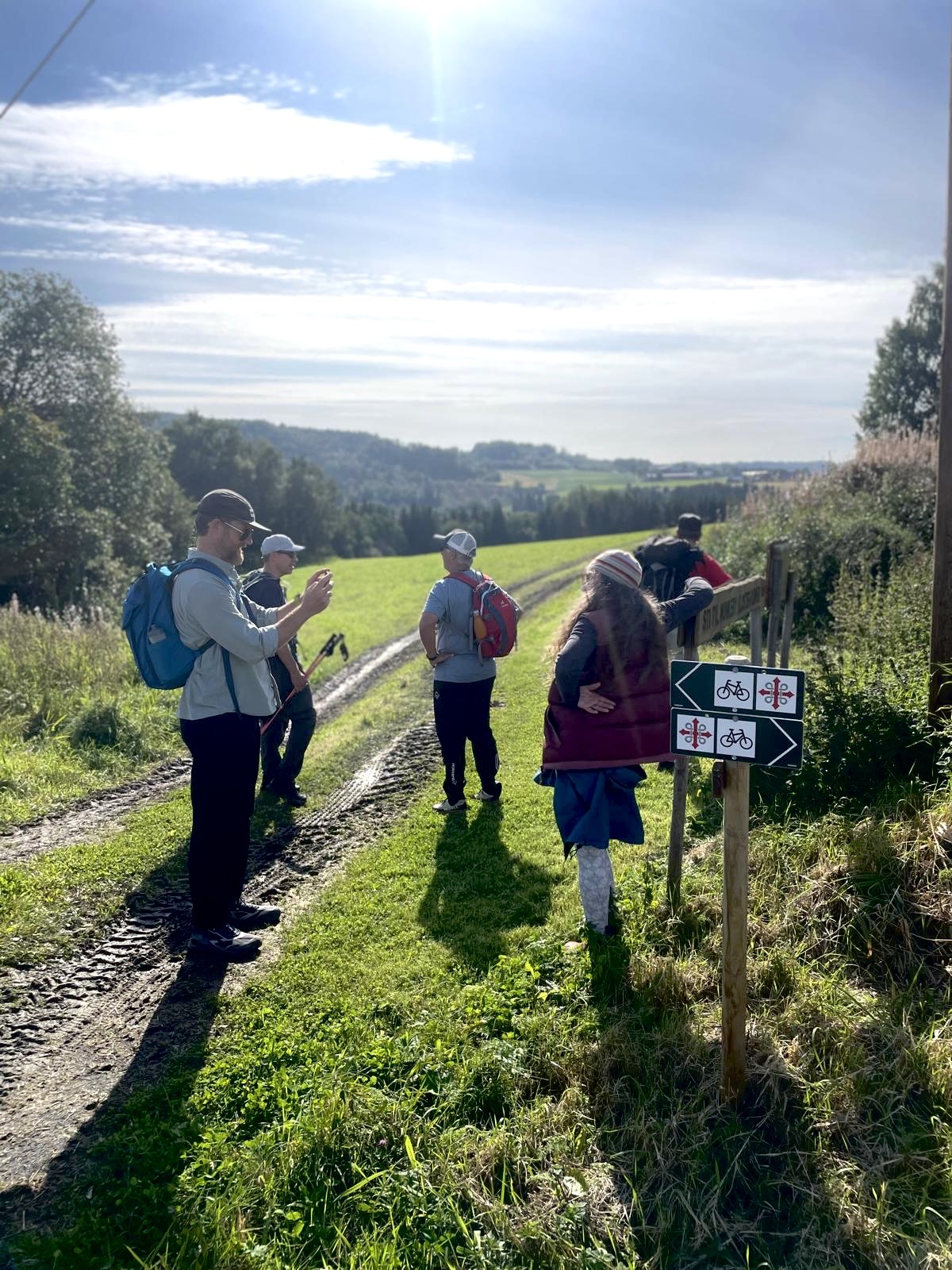We are excited to invite you to something really special: a weeklong pilgrimage along the historic St. Olav’s Way in Norway, from Stiklestad to Trondheim, taking place August 24–30, 2026.
For centuries, pilgrims have walked this path seeking meaning, a closer relationship to God, renewal, friendship, and a deeper connection to the world around them. Next summer, we would love for you to join us as we follow in their footsteps.
We’ll walk about 20 kilometers (around 12.4 miles) each day—enough to feel the journey in our bodies, but very doable for anyone in reasonably good shape.
Along the way we will share simple but nourishing fellowship: local food served at farms and hostels, stories from Norwegian history, reflections on the life of St. Olav, and the landscape that has shaped so much of this country’s soul. The pilgrimage will be led by a local priest, Kjartan Bergslid, who has been trained in Ignatian spirituality and who has led hundreds of pilgrims over the years. He is an inspiring spiritual guide and a great storyteller.
We will sleep simply but comfortably. Evenings will be spent in good company, resting our feet, sharing conversations, and maybe discovering something new about ourselves.
This isn’t just a hike. It’s a chance to slow down, breathe, learn, and walk, side by side, through some of Norway’s most meaningful terrain.
If you’re interested in joining us or would like more information, just reply to this email. I’d love to have you with us.
Here is a detailed itinerary for those of you who are interested:

Pilgrimage Stiklestad-Trondheim
The hike day by day:
Day 1: Stiklestad-Bakketun (3 km): Attendance at Bakketun Folk HighSchool for lunch at 1300. After lunch, there will be a start-up gathering atthe school. There will be a bus transport to Stiklestad. There will be a tourof the place where many will claim that Norway was created. We gather inStiklestad church (1180), built over the place where St.Olav fell on July 29,1030. There will be a simple liturgy with the distribution of pilgrim passes.We have dinner in the restaurant at Stiklestad. Then we walk the first threekilometers to Bakketun, spending the night in a double room.
Day 2: Bakketun- Munkeby (18 km).The trail goes through varied landscapes: Paths along the Verdal River, gravelroads through agricultural landscapes, and forest paths. At Halle, we holdmid-day prayers. Towards the end of the day, we can swim in a deep pool in theLevanger River. Munkeby Hostel offers accommodation and food on the farm withhouses from the 17th century. The hostel is 600 m from a monastery ruin fromthe 12th century and 400 m from the Cistercian monastery at Munkeby from 2009.At Munkeby, they serve good local food. We taste the cheese that the monks makeand the local Munkeby beer. Whoever wants gets to participate in time prayerwith the five Cistercian monks in the monastery.
Day 3: Munkeby- Laberget (19 km).The day starts with a peaceful walk from the Monastery ruin along the LevangerRiver. We then walk through the wooden house town of Levanger, where the NationalHeritage Board protects the entire center due to the unique wooden housebuildings from the beginning of the 20th century. We take a break in Levangerchurch in the city center. The walk then passes through the nursery inStaupslia and comes to the beautiful pilgrimage church Alstadhaug from 1180.Towards the end of the day, we walk along the Trondheimsfjord to Labergetcampsite.
Day 4: Laberget- Fånesbukta (23 km)The day starts with 6 km along the Trondheimsfjord. Then we come toFalstadsenteret. The place was one of the most brutal prison camps in Norwayduring World War II. Today, Falstad is a center for human rights with a museumin the basement. The pilgrimage route goes straight through Falstadskogen, witha memorial to over 2-300 people who were executed and buried here during thewar. The hike continues along an asphalt road through deep forests. Halfway, wecome to Sottjønna, where it is nice to dip. Towards the end of the day, we walkout to Frostalandet and Trondheimsfjorden again. We are picked up by bus inFånesbukta and driven to the beautiful Valberg family farm on Frosta. The placespecializes in gourmet food from the farm. The chef has composed a 3-coursepilgrim menu for us.
Day 5: Fånesbukta- Tautra (22 km).The day starts with bus transport back to Fånesbukta. The hike continues alongFrostastien, which runs along the fjord. At the small fishing village Småland,we go inland on the peninsula. The trail passes Logtun church (1500) andTinghaugen, where the Frosting Act was enforced from 400 AD. Furthermore, wehead out towards the monastery island of Tautra. We walk over a 2 km long pierto get to the island. Tautra is known for its unique bird life. A new nunnerywas built on the island for the Cistercian Order in 2006. The monastery has wonseveral awards for its architecture, and the monastery church has a veryspecial atmosphere of silence and prayer. We spend the night at the idyllicKlostergården, next door to the ruin of the Cistercian monastery, which wasinaugurated here in 1207. The monastery farm also focuses on local food, andthey have a farm shop and microbrewery where they make a renowned beer.
Day 6: Tautra- Nidaros Cathedral. Wespent the morning at Tautra, spending plenty of time experiencing the monastery.In the afternoon, we will travel by boat across the Strindfjord. We land on theoutskirts of the city. After a short walk, we arrive at Nidaros Cathedral,where St. Olav was buried in the 11th century. Here, we will receive the Letterfrom St.Olav as proof that we have walked more than 100 km along the pilgrimroute. We will spend the night in Nidaros pilegrimsgård, just 200 m from thecathedral.